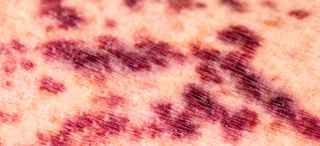Expert Treatment for Vasculitis
Vasculitis is a group of inflammatory disorders in the blood vessels that affects their walls and can restrict blood flow throughout the body. Vasculitis can eventually lead to organ and tissue damage, depending on which blood vessels are affected.
Our specialists conduct research that brings the most advanced therapies and diagnostic methods from the lab to the bedside for people with vasculitis. Combining our expertise with the newest medical advancements, UT Southwestern helps patients return to their healthy, active lives.
Types of Vasculitis
All types of vasculitis involve inflammation in blood vessels, but each type differs in the areas it affects. Vasculitis can be grouped by the size of the affected blood vessels, and some types include:
Large-Vessel Vasculitis
- Behcet's disease causes oral and genital ulcers (sores), skin lesions, and eye inflammation.
- Giant-cell arteritis affects the temporal artery, located on the side of the head.
- Polymyalgia rheumatica affects the shoulders and hips.
- Takayasu's arteritis affects the aorta and its branches.
Medium-Vessel Vasculitis
- Buerger's disease affects blood flow to the hands and feet.
- Kawasaki disease develops in children and affects blood vessels throughout the body.
- Polyarteritis nodosa affects the digestive tract, kidneys, nerves, skin, and potentially many other areas.
Small-Vessel Vasculitis
- Wegener’s granulomatosis, or granulomatosis with polyangiitis, affects organs such as the lungs, kidneys, and skin, as well as sinuses and joints.
- Churg-Strauss syndrome, or eosinophilic granulomatosis with polyangiitis, affects organs such as the heart, kidneys, lungs, nervous system, and skin.
- Cryoglobulinemia vasculitis occurs when abnormal proteins in the blood thicken and restrict blood flow.
- Henoch-Schonlein purpura, or IgA vasculitis, most often develops in children younger than age 11 and involves a buildup of abnormal IgA antibodies in the blood vessels of the skin, intestines, joints, and kidneys.
Causes of Vasculitis
The exact causes of vasculitis are not fully known. Experts believe that a gene or genetic variation could increase the risk of some types of vasculitis.
In some patients, vasculitis results from an immune system reaction, when the body’s immune system mistakenly attacks cells in blood vessel walls or tissue in surrounding blood vessels. Possible triggers for an immune system reaction include:
Symptoms of Vasculitis
The signs and symptoms of vasculitis vary by the type and the part of the body that’s affected. Symptoms can develop gradually or appear quickly.
General signs and symptoms:
- Fatigue
- Fever
- General aches and pains
- Headache
- Unexplained weight loss
Skin symptoms:
- Itching
- Red or purple bumps or spots
- Splotches, hives, or rashes
Joint symptoms:
Lung symptoms:
- Shortness of breath
- Coughing up blood
Digestive tract symptoms:
- Mouth ulcers
- Stomach or abdominal pain
- Ruptured intestinal wall caused by reduced blood flow
Ear, nose, throat, and sinus symptoms:
- Chronic infections in the sinuses or middle ear
- Ulcers inside the nose
- Hearing loss
Eye symptoms:
- Burning, pain, or redness in the eyes
- Light sensitivity
- Blurry vision
Central nervous system (brain, spinal cord, and nerves) symptoms:
- Headaches
- Reduced mental function
- Muscle weakness or paralysis
- Numbness, tingling, or weakness in parts of the body
- Shooting pain in the arms or legs
- Loss of sensation or strength in the hands or feet
Diagnosing Vasculitis
For people experiencing symptoms of vasculitis, our rheumatologists (specialists in diseases that affect joints, bones, muscles, and the immune system) conduct a thorough evaluation, which includes a:
- Physical exam
- Discussion of personal and family medical history
- Discussion of symptoms
To rule out other conditions and confirm a diagnosis of vasculitis, our doctors might recommend one or more tests, such as:
- Blood tests to look for signs of inflammation, such as high levels of C-reactive protein or erythrocyte sedimentation rate (ESR), or to check for specific antibodies that are present in some types of vasculitis
- Urine tests to check for the presence of red blood cells or a high level of protein
- Biopsy to take a small sample of tissue for examination under a microscope for signs of inflammation or tissue damage
Depending on each patient’s symptoms, we might use imaging to see which organs and blood vessels are affected. We can also monitor the effectiveness of treatment with imaging studies.
The types of imaging we might use include:
- Chest X-ray
- Computed tomography (CT) scan, specialized X-ray technology that takes cross-sectional images of the inside of the body and produces 3D images
- Magnetic resonance imaging (MRI) scan, which uses a large magnet and radio waves to produce detailed images of soft tissues
- Ultrasound, which uses sound waves to create detailed images inside the body
- Angiography, in which the doctor inserts a catheter (thin, flexible tube) into a large artery or vein to inject a special dye that shows outlines of blood vessels on X-rays
Treatment for Vasculitis
The goals of treatment are to reduce inflammation in the blood vessels to prevent complications and to treat the underlying disease that caused the vasculitis.
At UT Southwestern, our rheumatologists develop treatment plans tailored to each patient’s needs. Treatment options for vasculitis begin with medications such as:
- Corticosteroids taken as pills or intravenously to relieve inflammation
- Immunosuppressants to reduce immune system activity and inflammation
- Supplements of calcium and vitamin D to help prevent bone loss that can result from long-term corticosteroid treatment
In rare cases, part of a wall of a blood vessel can become thin and weak, causing it to bulge outward. This condition is known as an aneurysm, which often needs surgery to repair. Patients might also need surgery to open blocked arteries.




